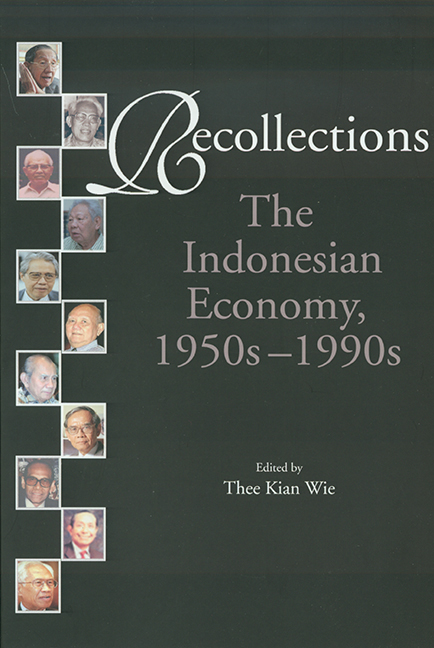Book contents
- Frontmatter
- Dedication
- Contents
- Foreword
- Preface
- Acknowledgments
- Introduction
- II Recollections
- 1 Sumitro Djojohadikusumo
- 2 Mohammad Saubari
- 3 Sjafruddin Prawiranegara
- 4 Abdoel Raoef Soehoed
- 5 Sarbini Sumawinata
- 6 Mohammad Sadli
- 7 Soedarpo Sastrosatomo
- 8 Suhadi Mangkusuwondo
- 9 Emil Salim
- 10 Subroto
- 11 Teuku Mohamad Daud
- Index
- About the Editor
11 - Teuku Mohamad Daud
from II - Recollections
Published online by Cambridge University Press: 21 October 2015
- Frontmatter
- Dedication
- Contents
- Foreword
- Preface
- Acknowledgments
- Introduction
- II Recollections
- 1 Sumitro Djojohadikusumo
- 2 Mohammad Saubari
- 3 Sjafruddin Prawiranegara
- 4 Abdoel Raoef Soehoed
- 5 Sarbini Sumawinata
- 6 Mohammad Sadli
- 7 Soedarpo Sastrosatomo
- 8 Suhadi Mangkusuwondo
- 9 Emil Salim
- 10 Subroto
- 11 Teuku Mohamad Daud
- Index
- About the Editor
Summary
YOUTH AND EDUCATION
After completing my primary education in Aceh, I left for Jakarta (then called Batavia) to pursue my secondary studies at a Dutch high school (Hogere Burgerschool, HBS). I had access to a Dutch education at this exclusive institution because my father was a hulubalang (a district chief in Aceh). I boarded with a Dutch family throughout my high school years in Jakarta.
When the Pacific War broke out and the Japanese invaded British Malaya, I was called back to Aceh by my parents. At the time there was no air transport, and travelling by sea was becoming dangerous. So I took the train from Jakarta to Merak and crossed the Sunda Strait by ferry to reach Tanjung Karang on the southern tip of Lampung. My father had sent a car all the way from Aceh to collect us. My younger brother and I took four days and four nights to reach our home in Samalanga, about 100 km from Lhokseumawe. I stayed there throughout the Japanese occupation.
THE STRUGGLE FOR INDEPENDENCE
During the Japanese occupation I received military training similar to that given to young Indonesians in Java when they joined PETA (Pembela Tanah Air, Defenders of the Fatherland), the Japanese-sponsored army, called ‘Gyogun’ in Aceh. This training lasted about 18 months.
After Sukarno and Hatta had proclaimed Indonesia's independence in August 1945, I decided to take part in the independence struggle, joining the newly established Army for the People's Security (Tentara Keamanan Rakyat, TKR), later renamed the Indonesian National Army (Tentara Nasional Indonesia, TNI). At the time I had no other employment, and had been influenced by Japanese propaganda to the effect that Indonesia would one day become independent.
We readily formed our own military force in my home district, and I became the commander of a regiment covering quite a vast area that included Lhokseumawe. From a military point of view we were quite strong, because a fully equipped Japanese regiment had surrendered all its weapons to us.
- Type
- Chapter
- Information
- RecollectionsThe Indonesian Economy, 1950s–1990s, pp. 251 - 264Publisher: ISEAS–Yusof Ishak InstitutePrint publication year: 2003

